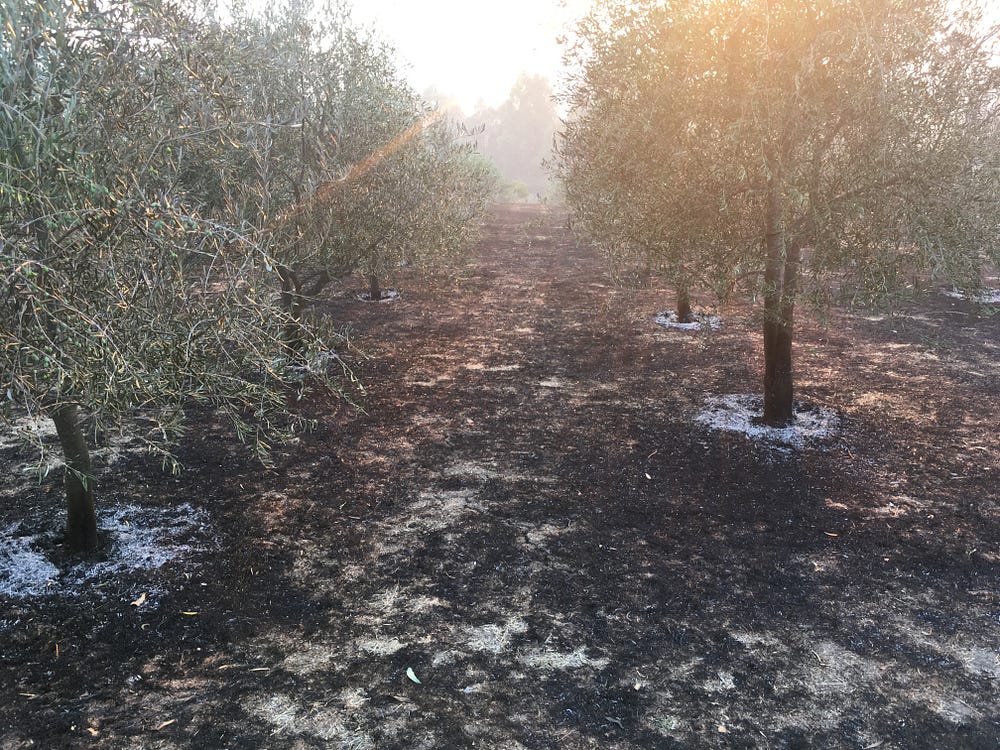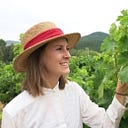The ironies and risks of farming and the natural world — the fire’s bite.
This is a bit of thinking aloud: the despair at how risky farming is, how it’s a never ending learning experience and how some of our attempts to work with nature actually made things worse. I wrote this to show just how difficult it is to make decisions in farming and how tantalising the short quick fixes can sometimes seem when your livelihood is on the line. I’m not saying quick fixes are good in the long-term, quite the opposite, but I think for ecological agriculture to work we have to re-think how we treat and work with farmers. We need to understand why they make the decisions they do, where they are coming from and so here goes…
In January 2017 a fire burst from the 100s of hectares of pine forests surrounding our farm. It burnt everything except the main buildings which the amazing volunteer firefighters fought through the night to save. What the fire left behind was a black and brown wasteland, spines of trees in every direction, our 12 hectares of crops burnt to a crisp. We had always known a fire would come at some point but this was so much worse than we had ever imagined was possible, as 120 fires blazed across Chile, it was a national disaster. No one from the forestry companies helped to contain the blazes that ripped through their mass monoculture forests. We were almost two weeks into the 600,000 hectares burning. The fires had been making their way across the country for days…no one had any resources left.
We also had not foreseen how our actions to help the plants would become their enemy as the fire spread across the land. It was such a painful shock to return to the farm Monday morning and realise that in some of our attempts to work with nature, we added to fuel of the flames.
All I could think was ‘How can this be? How can our regenerative farming practices have helped cause more damage as the fire came through?’
Nature’s paradoxes:
Early on in establishing our farm some of the olive trees were struggling, so we had tried using organic fertiliser as a short term solution but it was clear the soil life wasn’t in good shape, we realised that the fertiliser was just treating symptoms and we wanted to work with the cause…work with the whole system. This was where our quest to work with nature started — unhealthy plants inevitably means unhealthy soils and so we looked to nurture our soils. Our neighbours had begun to do the same…it felt like we were all taking steps to correct our mistakes, to work with the natural world — the ironic twist is that these steps turned out to be the fire’s friend as these examples show.


Bare earth — the best fire retardant and the soil’s enemy
The fire’s biggest friend was that we haven’t ploughed the land in years, so there was no bare earth around and it licked from one bit of dry stubble to the next. About 10 years ago, before planting the olive trees, we dug the old roots out from past crops and churned up the soil to quite a depth — we didn’t realise the impact this would have, that it would totally disturb the soil’s structure, biology and chemistry. Ever since the land has been recovering, moving through different stages of weeds as the soil life evolves below. We realised ploughing is definitely not how nature does things. We never broke the ground again. We have of course always kept the weeds cut super low to reduce fire risk in the long dry Summers. As it turns out, this wouldn’t be enough.
Walking through the blackened landscape and torched trees, Claudio said “We need to plough– turning the earth will prevent fire damage like this again.” When the earth is bare dirt, there’s nothing to burn. This was so painful to hear, the opposite of what we had been doing the last 10 years, the opposite of helping the soil to build itself.

Chop and drop mulching — a haven for soil life and a bonfire
In order to increase soil organic matter (living organisms in the soil) we started to leave all the prunings at the base of the trees. This pile of prunings was a little haven for creatures and fungi and bacteria — all the good stuff that would help to create good soil conditions. Plus, this way each tree kept a bit more moisture at its base so that late frosts didn’t hit as hard.
Right after the fire on Monday morning, it was clear we had essentially built a little bonfire at the base of each tree. The fire ripped through the grove on the few inches of grass, but lingered at each tree burning that bit hotter and for that bit longer at the tree base.

Grass cover crops — biodiversity and channels of fire
Our neighbours had also been using more organic methods, leaving the harmless grasses in the vineyards, composting their cuttings and generally using sustainable farming practices. In recent years, they had even had problems selling their grapes as buyers saw the weeds in the vineyards and refused to buy. To the buyers the weeds were messy, signified a lack of care and a sign of bad quality grapes. In truth, these grapes were in better shape than ever but deep-seated conventions meant buyers were unconvinced.
As the fires loomed large and our neighbours livelihood was on the line they told us, “That’s it, we’re going to kill every weed in our vineyards from now on. We are risking too much. Without the weeds the vines wouldn’t burn.” And that’s what they have done.
Our hearts sank. There was little we could say in response. They were right, no weeds will stop the fire from progressing.
Farming is risky
And so it seems that once again I find myself confronted by the extremely risky world of farming, this isn’t the first thing that has not gone to plan. When your livelihood depends on the land and you are subject to all the elements greeting you at any time, it only makes sense to do everything in your power to minimise the risk. What would you do from here if your livelihood was at risk? Would you use harsh chemicals to kill the weeds on your soil? Would you plough the land to create a constant firebreak?
We have chosen to do neither and are ardently pursuing alternatives. It seems cactus and warm-season perennials may provide some of the answers to keeping the land more moist and fire resistant during the ever hotter Summer months, but it’s still early days. Of course it will take some time to tell how they work… perhaps even risking the plants to another fire. Are we mad? What will it take to build this into a sustainable business? I can see why farmers turn to quick fixes and silver bullets that appear to stop these risks of devastation.
Long term thinking
I don’t think we are mad, I actually think we are onto something that will take time to build but will leave us more resilient in the long term. It’s becoming more and more clear that quick fix attempts to control nature cause more problems in the long run. The mass-monoculture pine forests are a case in point: they were lost in one fowl swoop, accentuating the fire to new heights, leaving utter destruction in their wake, but amazingly those flames were controlled by the native woodland on our land — the fire didn’t progress to our neighbours farm. There was no change in wind, no rain, the temperature didn’t drop but the fire petered as it hit the native forests. To me, that’s a pretty clear message that forest fires on these scales are manmade phenomenons not just nature doing it’s thing.
And so, despite the hurt and shock of recent events, the green will return and we will continue to listen, learn and work with nature in our pursuit of a more resilient future.

